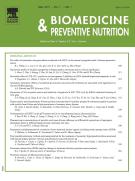Protective effects of deferiprone and desferrioxamine in brain tissue of aluminum intoxicated mice: An FTIR study - 18/02/14
 , Chandra Prasad Khatiwada a, Jeganathan Sivasubramanian a, Boobalan Raja b
, Chandra Prasad Khatiwada a, Jeganathan Sivasubramanian a, Boobalan Raja bAbstract |
The present study was designed to study aluminum chloride which caused marked alterations in biochemical parameters such as glutathione peroxidase, catalase, superoxide dismutase, and TBARS in brain tissues of mice. Fourier transform infrared spectroscopy spectra reflect the alterations on major biochemical constituents in brain tissues of mice such as proteins, lipids and nucleic acids due to the overproduction of ROS. Furthermore, administration of deferiprone and deferoxamine significantly improved the level of protein and shifted back the peak positions of amide I and II to near control values indicating tau protein, β-amyloid, amyloid plaques and neurofibrillary tangles decreased, consequently protected from Alzheimer's disease and other major risk factor of many neuronal dysfunctions in brain tissues. Therefore, aluminum toxicity is a widespread crisis to all living organisms, including both flora and fauna. Furthermore, it causes widespread degradation of the environment and health. Therefore, the present investigation suggested that DFO and DFP are efficient chelators for aluminum poisoning and they reduced the aluminum concentration.
Le texte complet de cet article est disponible en PDF.Keywords : Aluminum, Biochemical parameters, DFO and DFP, FTIR
Plan
Vol 4 - N° 1
P. 53-61 - janvier 2014 Retour au numéroBienvenue sur EM-consulte, la référence des professionnels de santé.
L’accès au texte intégral de cet article nécessite un abonnement.
Déjà abonné à cette revue ?

